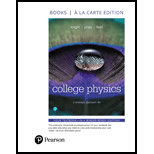
Concept explainers
Internal injuries in vehicular acci-dents may be due to what is called the “third collision.” The first collision is the vehicle hitting the external object. The second collision is the person hitting something on the inside of the car, such as the dashboard or windshield. This may cause external lacerations. The third colli-sion, possibly the most damaging to the body, is when organs, such as the heart or brain, hit the ribcage, skull, or other confines of the body, bruising the tissues on the leading edge and tearing the organ from its supporting structures on the trailing edge.
a. Why is there a third collision? In other words, why are the organs still moving after the second collision?
b. If the vehicle was traveling at 60 mph before the first collision, would the organs be traveling faster than, equal to, or slower than 60 mph just before the third collision?
Learn your wayIncludes step-by-step video

Chapter 4 Solutions
College Physics: A Strategic Approach, Books a la Carte Edition (4th Edition)
Additional Science Textbook Solutions
Brock Biology of Microorganisms (15th Edition)
Human Physiology: An Integrated Approach (8th Edition)
Microbiology: An Introduction
Chemistry: Structure and Properties (2nd Edition)
Microbiology: An Introduction
Microbiology with Diseases by Body System (5th Edition)
- A 11.8 L gas tank containing 3.90 moles of ideal He gas at 26.0°C is placed inside a completely evacuated insulated bell jar of volume 39.0 L .A small hole in the tank allows the He to leak out into the jar until the gas reaches a final equilibrium state with no more leakage. Part A What is the change in entropy of this system due to the leaking of the gas? ■ ΜΕ ΑΣΦ AS = ? J/K Submit Request Answer Part B Is the process reversible or irreversible?arrow_forwardA-E pleasearrow_forwardThree moles of an ideal gas undergo a reversible isothermal compression at 20.0° C. During this compression, 1900 J of work is done on the gas. For related problem-solving tips and strategies, you may want to view a Video Tutor Solution of Entropy change in a free expansion. Part A What is the change of entropy of the gas? ΤΕ ΑΣΦ AS = Submit Request Answer J/Karrow_forward
- 5.97 Block A, with weight 3w, slides down an inclined plane S of slope angle 36.9° at a constant speed while plank B, with weight w, rests on top of A. The plank is attached by a cord to the wall (Fig. P5.97). (a) Draw a diagram of all the forces acting on block A. (b) If the coefficient of kinetic friction is the same between A and B and between S and A, determine its value. Figure P5.97 B A S 36.9°arrow_forwardPlease take your time and solve each part correctly please. Thank you!!arrow_forwardhelp me answer this with explanations! thanks so mucharrow_forward
- No chatgpt pls will upvote Alreadyarrow_forwardWhat fuel economy should be expected from a gasoline powered car that encounters a total of 443N of resistive forces while driving down the road? (Those forces are from air drag, rolling resistance and bearing losses.) Assume a 30% thermodynamic efficiency.arrow_forwardNo chatgpt pls will upvotearrow_forward
- 12. What is the angle between two unit vectors if their dot product is 0.5?arrow_forwardIf the car in the previous problem increases its power output by 10% (by pressing the gas pedal farther down), at what rate will the car accelerate? Hint: Consider the net force. In the previous problem the power was 31.8kWarrow_forwardWhat power is required (at the wheels) for a 1400 kg automobile to climb a 4% grade at a constant speed 30 m/s while it is opposed by drag and rolling resistance forces totaling 500 N?arrow_forward
 University Physics Volume 1PhysicsISBN:9781938168277Author:William Moebs, Samuel J. Ling, Jeff SannyPublisher:OpenStax - Rice University
University Physics Volume 1PhysicsISBN:9781938168277Author:William Moebs, Samuel J. Ling, Jeff SannyPublisher:OpenStax - Rice University Physics for Scientists and Engineers, Technology ...PhysicsISBN:9781305116399Author:Raymond A. Serway, John W. JewettPublisher:Cengage Learning
Physics for Scientists and Engineers, Technology ...PhysicsISBN:9781305116399Author:Raymond A. Serway, John W. JewettPublisher:Cengage Learning College PhysicsPhysicsISBN:9781938168000Author:Paul Peter Urone, Roger HinrichsPublisher:OpenStax College
College PhysicsPhysicsISBN:9781938168000Author:Paul Peter Urone, Roger HinrichsPublisher:OpenStax College Principles of Physics: A Calculus-Based TextPhysicsISBN:9781133104261Author:Raymond A. Serway, John W. JewettPublisher:Cengage Learning
Principles of Physics: A Calculus-Based TextPhysicsISBN:9781133104261Author:Raymond A. Serway, John W. JewettPublisher:Cengage Learning Physics for Scientists and Engineers: Foundations...PhysicsISBN:9781133939146Author:Katz, Debora M.Publisher:Cengage Learning
Physics for Scientists and Engineers: Foundations...PhysicsISBN:9781133939146Author:Katz, Debora M.Publisher:Cengage Learning Classical Dynamics of Particles and SystemsPhysicsISBN:9780534408961Author:Stephen T. Thornton, Jerry B. MarionPublisher:Cengage Learning
Classical Dynamics of Particles and SystemsPhysicsISBN:9780534408961Author:Stephen T. Thornton, Jerry B. MarionPublisher:Cengage Learning





